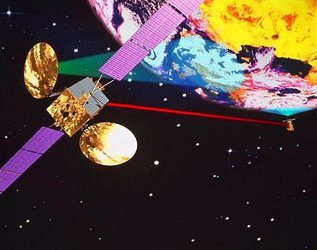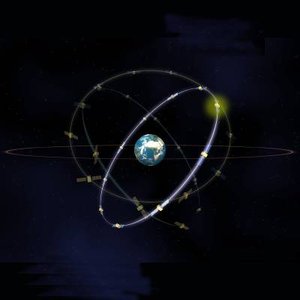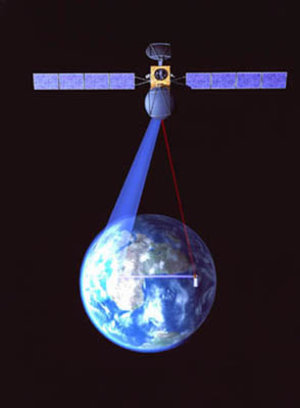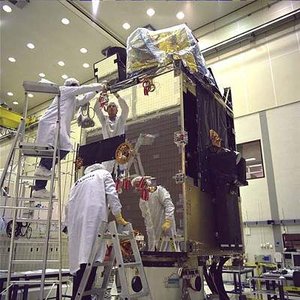Mobile communications
Anytime anywhere
To be able to speak to or contact someone by mobile phone, fax or email from anywhere at whatever time of day and night is something that we are all becoming accustomed to.
Thanks to the European Mobile System (EMS) operated through Eutelsat via the Italsat 2 satellite we are seeing the benefits that satellites can bring to modern telecommunication systems. Calls typically costing approximately 2 Euros per minute are vying with terrestrial systems but the real benefits of satellite systems are their wider coverage and flexibility - an advantage that proves invaluable in unpopulated or remote areas.
And now, with the launch of Artemis, the coverage and capability of a European-wide communication system will be further enhanced.
The L-Band Land Mobile (LLM) payload provides mobile communication services throughout western Europe and neighbouring regions, including the Mediterranean, the Middle East and parts of Russia.
The four beam coverage consisting of a wide 'Eurobeam', which covers the entire area, and three spot beams focussing on specific areas. In total the system has up to four times the capacity of its predecessor, offering simultaneous use of up to 662 voice and data channels.
Communication systems, particularly in parts of Africa and Europe previously lacking reliable facilities, will become as much a part of a global network as anywhere else in western Europe. Services will be more streamlined, faster, more reliable and on the whole cheaper than ever before with call charges anticipated to drop by at least one Euro per minute as the new satellite services infiltrate the mainstream commercial market.
Navigation
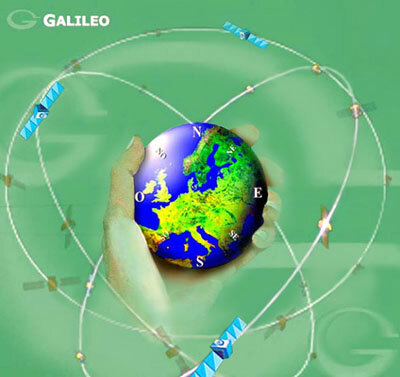
Precision navigation for everyone
America and Russia have been using satellites for accurate navigation for many years. Their GPS and Glonass systems allow moving or fixed objects in the air, on land or at sea to determine positions with high accuracy. But until now, it is the military that has been almost the sole beneficiary of such technology, with civilian use of these systems restricted.
Now, Europe is bringing advanced satellite navigation to the civilian population with Galileo, a European global satellite navigation system set to transform our land and sea transport and revolutionise air traffic control world-wide.
The first stepping stone in this ambitious programme is EGNOS (European Geostationary Navigation Overlay System) - a joint programme between ESA, Eurocontrol and the European Commission.
The first orbital element built by ESA is the navigation payload onboard Artemis. Positioned over Africa and working alongside Inmarsat-3, AOR-E and IOR telecommunications satellites, an Artemis transponder will broadcast navigation signals from the EGNOS Master Control centre (MCC).
This data, which carries integrity and differential correction information applicable to the GPS and Glonass satellites will ultimately allow safety critical users like aircraft, ships or emergency vehicles to rely solely on satellite navigation.
In the future aeroplanes will be able to take off and land in fog with confidence and ships will be able to manoeuvre in and out of ports without having to contact shore-based services. It will be a common occurrence for trucks, and other land-based transport, particularly in remote areas, to find their way around via satellite links. Even our personal cars will be equipped with navigation systems to help us plan our routes and get around more easily.
Satellite to Satellite Communications

A focal point in space
As more and more satellites fill the space above us, we are inventing better and faster ways of getting the information that they produce back down to Earth. Data relay, or satellite to satellite communication, is becoming increasingly important.
Artemis acts as a focal point - a kind of space based interpreter. Onboard it carries one of the most advanced data relay payloads ever developed by ESA. Known as the SKDR, it is the first system to operate both the S Band and Ka Band frequencies as well as optical wavelengths through a unique laser called SILEX.
Artemis not only communicates information between scientists based on the International Space Station and Earth, but also has a key role to play in Earth observation by receiving data from Earth observing satellites in low earth orbit and relaying it directly to the relevant ground station in a fraction of the time
The French Spot 4 satellite, which already includes a SILEX terminal, is linked with Artemis and image data can now be sent to the Toulouse processing centre in near 'real-time'. Until now this could take up to a day to reach its final destination.
Another Silex user will be the Japanese satellite OICETS.
ESA's giant Earth observing satellite, Envisat, successfully launched on 1 March 2002 (CET), will also benefit from Artemis' high-rate data-relay capabilities to send information quickly and efficiently down to Earth.





